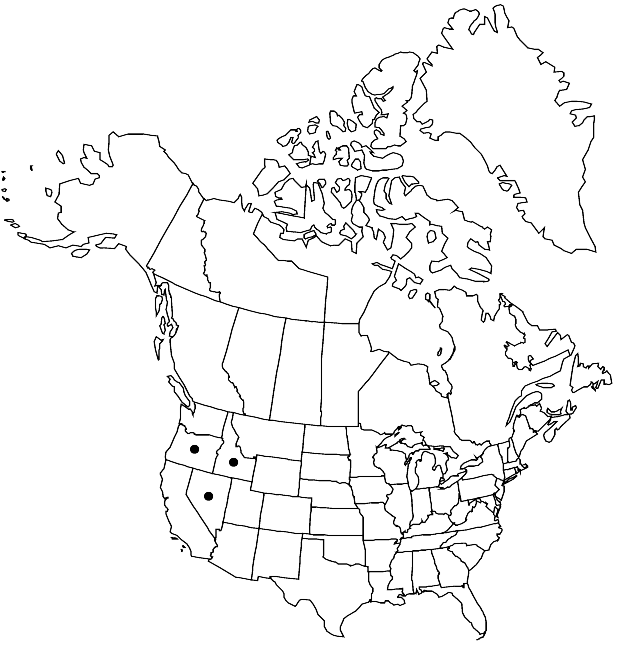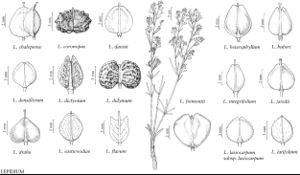Lepidium davisii
Madroño 9: 164. 1948.
Perennials; (cespitose, caudex woody, many-branched, with persistent petiolar remains); puberulent. Stems simple from base, erect, unbranched or branched (few) distally, (0.2–) 0.5–1 (–1.4) dm. Basal leaves (often deciduous); not rosulate; blade spatulate to oblanceolate, 1–2.5 (–3.2) cm × 2–6 (–9) mm, margins entire or apically 3 (–5) -toothed or lobed. Cauline leaves sessile; blade usually oblanceolate or oblong, rarely obovate, (0.8–) 1.3–2.5 cm × (2–) 4–7 mm, base obtuse or cuneate, not auriculate, margins entire or apically 3 (–5) -toothed. Racemes slightly elongated in fruit; rachis puberulent, trichomes straight or curved. Fruiting pedicels divaricate-ascending, straight, (slender or slightly stout, terete), (2.5–) 3–4.2 (–5) × 0.4–0.5mm, usually puberulent throughout, rarely glabrate. Flowers: sepals suborbicular to oblong-ovate, 1.2–2 × 1–1.5 mm; petals white, obovate, 2–3.2 (–4) × 1.5–2 mm, claw 0.5–1 mm; stamens 6; filaments 1.7–2.3 mm, (glabrous); anthers 0.4–0.7 mm. Fruits suborbicular to broadly ovate, (2.5–) 3–4.3 (–5) × (2–) 2.3–4 mm, apically winged, apical notch 0.1–0.4 mm deep; valves thin, smooth, not veined, glabrous or sparsely puberulent; style 0.5–1 mm, exserted beyond apical notch. Seeds oblong-ovate, (1.8–) 2–2.3 × 1–1.2 mm. 2n = 32.
Phenology: Flowering May–Jun.
Habitat: Playas of sagebrush plains and mesa, vernal ponds
Elevation: 800-1600 m
Distribution

Idaho, Nev., Oreg.
Discussion
Lepidium davisii is restricted to six counties in Idaho (Ada, Elmore, Owyhee, Twin Falls), Nevada (Elko), and Oregon (Malheur).
Selected References
None.
Lower Taxa
"elongated" is not a number."thick" is not a number."dm" is not declared as a valid unit of measurement for this property."dm" is not declared as a valid unit of measurement for this property.
